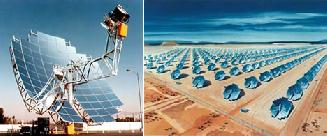
What’s happening right now?
Solar power is the basis for all life on earth. Although there are numerous other methods of generating electricity, solar panels have a number of considerable advantages for the consumer, the producer and the environment. Though solar cells are highly efficient in the laboratory, their efficiency lessens with a rise in temperature or with the degradation of the surface of these panels. Gradual degradation of the surface of solar panels, which are designed to function for decades, reduces the amount of sunlight that hits the energy-generating layer of the panels, which further reduces the amount of energy that is produced by it.
Since the world today needs efficient systems that can use renewable sources of energy to generate usable electricity, scientists are focusing on next-gen photovoltaic cells that can repair themselves in case they’re damaged during normal use. While most of these systems are still on paper and need to the tested in the real world, they do provide a glimpse of the future, where solar panels will be longer lasting and will help in providing clean energy at a low cost.
Trends:
Charles Fritts invented the first solar cell in 1883, by coating selenium, a semiconductor with a very fine layer of gold, to form junctions. But its efficiency was only 1 percent. Since then scientists have been discovering new techniques to overcome this drawback of low efficiency. Efficiency of solar panels depends directly on the surface quality of the panels, which when it degrades, reduces the amount of sunlight that can hit the energy-generating layer. To better the credentials of these panels, scientists over the world have focused their attentions on materials that can repair themselves if damaged to make sure that photovoltaic panels can produce the maximum possible output. Here are some of the trends in the field that can one day be used to produce highly efficient photovoltaic panels.
1) Self-healing solar cells by MIT:

A team of researchers at MIT have developed a self-healing solar cell that takes inspiration from nature. They figured out that ingredients within plant’s leaves that turn sunlight into usable energy aren’t actually immune to sun’s damage. They used their research to build a “dynamic” solar cell, where the light capturing material is a mixture of several chemicals, including a photosensitive protein, a fatty substance called phospholipid and carbon nanotubes. The team found that when soapy liquid was added to the mix, the components of the material break apart and form a soapy solution. However, when they put the material in a special bag with holes that only let the soapy molecules leak out, the disordered mess turns into a structured material, which can turn sunlight into electricity.
2) Self-healing solar cells by Purdue University:

Researchers at Purdue University have created a new type of solar cell designed to self-repair like natural photosynthetic systems in plants by using carbon nanotubes and DNA, an approach aimed at increasing service life and reducing costs.
3) Self-healing solar cells using discotic liquid crystals by Indiana University:

A team of researchers at the Indiana University have made a new type of multichromatic liquid crystals that can be used for organic solar cells. The use of this liquid makes solar cells capable of self-healing as a result of the low viscosity of liquid crystalline phase at ambient temperatures.
The concept:
Solar cells that include self-healing materials can continuously produce electricity over the long run without losing any efficiency. The problem lies with the surface of the photovoltaic panel that is used to cover the energy producing layer. The sun’s rays are brutal and the effect of it can be seen in plant leaves that use solar energy for all plant mechanisms. However, leaves constantly build new photosynthetic reaction centers that replace those that are damaged by intense ultraviolet light. Mimicking the same in photovoltaic cells can make solar cells more durable and even give them an indefinite lifespan.
The Advantages:
The advantages of self-healing solar panels are many. Since self-healing panels won’t degrade, they can efficiently produce renewable electricity for a longer period of time. Since solar panels are expensive, a longer running panel will produce more electricity at a reduced cost. Such panels are also great for large-scale solar farms, as they can reduce maintenance costs.
The Impact:
At present, the cost of renewable solar energy is much more than the cost of electricity that is produced using conventional ways. While solar panels are expensive, the cost of energy they produce over time could be reduced if these panels have a longer lifespan. With similar advancements, renewable electricity produced using solar energy can be made more affordable and lucrative for the masses.




